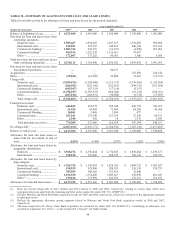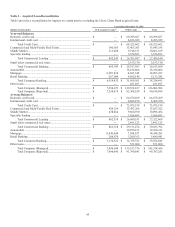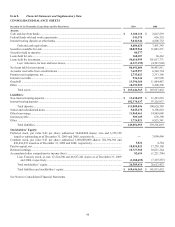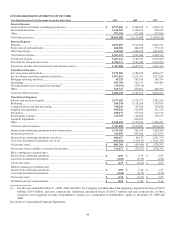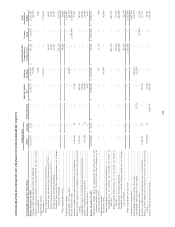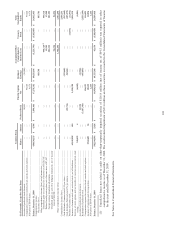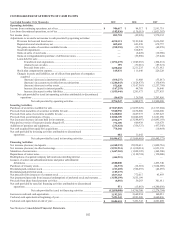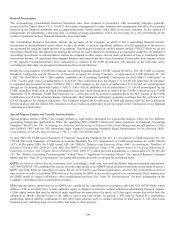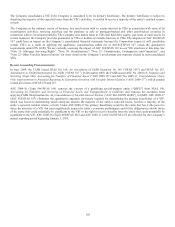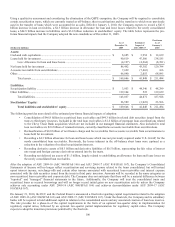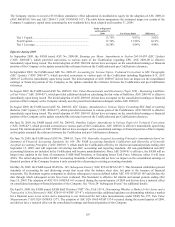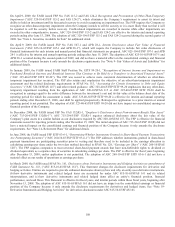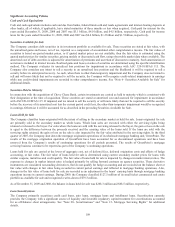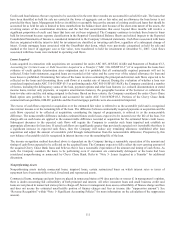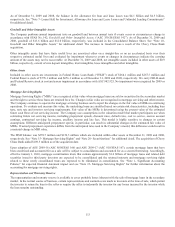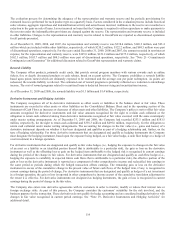Capital One 2009 Annual Report Download - page 117
Download and view the complete annual report
Please find page 117 of the 2009 Capital One annual report below. You can navigate through the pages in the report by either clicking on the pages listed below, or by using the keyword search tool below to find specific information within the annual report. 104
Basis of Presentation
The accompanying Consolidated Financial Statements have been prepared in accordance with accounting principles generally
accepted in the United States (“U.S. GAAP”) that require management to make estimates and assumptions that affect the amounts
reported in the financial statements and accompanying notes. Actual results could differ from these estimates. In the opinion of
management, all adjustments, consisting only of normal recurring adjustments, which are necessary for a fair presentation of the
results of operations in these financial statements, have been made.
The Consolidated Financial Statements include the accounts of the Company in which it has a controlling financial interest.
Investments in unconsolidated entities where we have the ability to exercise significant influence over the operations of the investee
are accounted for using the equity method of accounting. This includes interests in variable interest entities (“VIEs”) where we are not
the primary beneficiary. Investments not meeting the criteria for equity method accounting are accounted for using the cost method of
accounting. Investments in unconsolidated entities are included in other assets, and our share of income or loss is recorded in other
non-interest income. All significant intercompany balances and transactions have been eliminated. Certain prior year amounts related
to the segment reorganization have been reclassified to conform to the 2009 presentation. All amounts in the following notes,
excluding per share data, are presented in thousands unless noted otherwise.
During the second quarter of 2009, the Financial Accounting Standards Board (“FASB”) issued SFAS No. 168, The FASB Accounting
Standards Codification and the Hierarchy of Generally Accepted Accounting Principles—a replacement of FASB Statement No. 162
(“ASC 105-10-65/SFAS 168”). This standard establishes the Accounting Standards Codification for the FASB (“Codification” or
“ASC”) as the single source of authoritative U.S. GAAP. The Codification does not change U.S. GAAP, but rather how the guidance
is organized and presented to users. Effective July 1, 2009, changes to the source of authoritative U.S. GAAP are communicated
through an Accounting Standards Update (“ASU”). ASUs will be published for all authoritative U.S. GAAP promulgated by the
FASB, regardless of the form in which such guidance may have been issued prior to release of the FASB Codification (e.g., FASB
Statements, EITF Abstracts, FASB Staff Positions, etc.). ASUs also will be issued for amendments to the SEC content in the FASB
Codification as well as for editorial changes. Subsequently, the Codification will require companies to change how they reference U.S.
GAAP throughout the financial statements. The Company adopted the Codification in 2009 and has provided the pre-Codification
references along with the related ASC references to allow readers an opportunity to see the impact of the Codification on our financial
statements and disclosures.
Special Purpose Entities and Variable Interest Entities
Special purpose entities (“SPEs”) are broadly defined as legal entities structured for a particular purpose. There are two different
accounting frameworks applicable to SPEs: the qualifying SPE (“QSPE”) framework under Statement of Financial Accounting
Standard (“SFAS”) No. 140, Accounting for Transfers and Servicing of Financial Assets and Extinguishments of Liabilities (“ASC
860-10/SFAS 140”) and the VIE framework under Financial Accounting Standards Board Interpretation No. 46 (Revised 2003),
Consolidation of Variable Interest Entities (“VIE”), (“ASC 810-10/FIN 46(R)”).
In June 2009, the FASB issued Statement of Financial Accounting Standards No. 166, An Amendment of FASB Statement No. 140
(“SFAS 166”) and Statement of Financial Accounting Standards No. 167, Amendments to FASB Interpretation No. 46(R) (“SFAS
167”). In December 2009, the FASB issued ASU No. 2009-16, Transfers and Servicing (Topic 860): Accounting for Transfers of
Financial Assets (“ASU 2009-16”) and ASU No. 2009-17, Consolidations (Topic 810): Improvements to Financial Reporting by
Enterprises Involved with Variable Interest Entities (“ASU 2009-17”), which provided amendments to various parts of FAS 166 and
167. See “Recent Accounting Pronouncements” within “Note 1- Significant Accounting Policies” for expected financial statement
impact and See “Note 20- Securitizations” for further information about the accounting for securitized loans.
QSPEs are passive entities that are commonly used in mortgage, credit card, auto and installment loan securitization transactions.
ASC 860-10/SFAS 140 establishes the criteria an entity must satisfy to be a QSPE which includes restrictions on the types of assets a
QSPE may hold, limits on repurchase of assets, the use of derivatives and financial guarantees, and the level of discretion a servicer
may exercise to collect receivables. SPEs that meet the criteria for QSPE status are not required to be consolidated. The Company uses
the QSPE model to conduct off-balance sheet securitization activities. See “Note 20- Securitizations” for more information on the
Company’s off-balance sheet securitization activities.
VIEs Special purpose entities that are not QSPEs are considered for consolidation in accordance with ASC 810-10/FIN 46(R), which
defines a VIE as an entity that (1) lacks sufficient equity to finance its activities without additional subordinated financial support;
(2) has equity owners that lack the ability to make significant decisions about the entity; or (3) has equity owners that do not have the
obligation to absorb expected losses or the right to receive expected returns. In general, a VIE may be formed as a corporation,
partnership, limited liability corporation, or any other legal structure used to conduct activities or hold assets. A VIE often holds
financial assets, including loans or receivables, real estate or other property.


